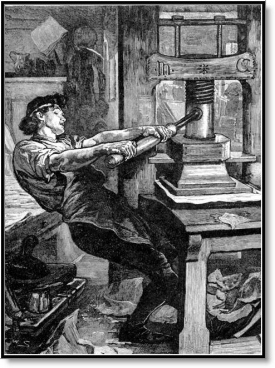
Writing, when it is professional, is constructed like sculpture. Whereas speech, is the medium of real time. What writing is has been formed by the technical practices developed around typography and printing. The idea of real-time writing is a contradiction, it violates the standards of professional production. Professional writing must operate within the limitations of the medium of print.
Imagine a communications medium that could only be produced at best once a day, or once a week or a month. Or in many cases, only one time, ever. And once its product had been produced, the capacity to change it did not exist. The physical qualities of the medium of ink, type and paper dictate the professional qualities of the writing process. The alphabetic sequences to be published must be perfect, or as complete as humanly possible. Ink, painted on type, and pressed onto paper is a bell that can’t be unrung. A mistake is a stain on the permanent record.
From the perspective of the ink-stained wretch, faster news cycles mean a lowering of standards. There isn’t time enough to be professional. And the concept of real time is the equivalent of broadcasting false information. Real time is attacked as having no accountability, no standards, no credibility and no real value. The permanence with which ink is fixed to paper is a metaphor for the assurance with which the signifiers are bound to the signifieds.
The history of real-time writing is also connected to the technical limitations of particular communications media. The telegraph enabled a kind of real-time writing. Messages could be encoded and sent back and forth instantaneously across a wire. Because of its scarcity as a resource, it was rarely used as a medium for casual conversation. Although one can imagine the professional operators of the equipment occasionally sending personal messages to each other in real time. This medium, once it became technologically boring, evolved into instant messenger conversations across the Network.
To understand the epochal change writing is experiencing, one must look to the changes in the quality of the medium through which writing is transmitted. The professionals of the previous medium prefer to move the discussion toward standards and practices, as though hypertext and the Network were another kind of printing press. But this is just a red herring, an attempt to frame the challenges of new medium within the strictures of the old medium.
The moment that the time and cost of changing one letter in an alphabetic sequence to any other letter approached zero, the medium was fundamentally changed. Adding, modifying and deleting text are not only possible, they are fundamental to real-time writing. Hyperlinking and comments open up the space even more. And these changes extend not just to production methods, but to the culture, standards and practices of writing. It is a transvaluation of all values. And of course, the practitioners of the previous medium will claim it’s the absence of values, the abandonment of the commitment to truth.
Real-time writing has the quality of a transparent on-going investigation, new facts can, and do, change the story. It’s a time-bound performance, with a beginning, middle and end. A melody is laid down and explored through improvisations and variations on the theme. Print has no duration, time matters with hypertext on the Network. In the previous regime, information was excluded to meet the deadlines proscribed by the technical requirements of the print medium. If new information arrived after the deadline, that was just too bad. In real-time writing, that same process would be called suppression, and the new information would emerge through other dynamic publication endpoints. The capacity to incorporate new information, and to listen to comments for new perspectives, fundamentally changes what counts as professionalism. Cable television news networks, when they engage in on-going coverage of a live event, operate within the value system of this new medium. Although, they can no longer restrict their inputs to a selection of their own correspondents and a few newswires.
Mastering the live mix (remix) of the real-time performance— of writing the new hyper-text, has many points in common with role of the MC in hip-hop music:
…Rapping, also referred to as MCing or emceeing, is a vocal style in which the performer speaks rhythmically and in rhyme, generally to a beat. Beats are traditionally generated from portions of other songs by a DJ, or sampled from portions of other songs by a producer, though synthesizers, drum machines, and live bands are also used, especially in newer music. Rappers may perform poetry which they have written ahead of time, or improvise rhymes on the spot with or without a beat. Though rap is usually an integral component of hip hop music, DJs sometimes perform and record alone, and many instrumental acts are also defined as hip hop.
As a story plays out across the Network, as new information is uncovered, the inputs are routed through the mixing board of the writer’s keyboard. A writer must now listen to how the whole jam is sounding— the writer is a player down in the groove with other players. As we learn to write through a real-time medium, we’ll need to look to the values, standards and practices of live performance. But these performances aren’t necessarily the traditional one-to-many events unfolding within a proscenium. We’ll need to dig into the performance theories of Richard Schechner and the Happenings of Allan Kaprow; revive the thoughts of Michael Kirby and The Art of Time, and the work of Fluxus. The journey from text on a page to hypertext on the Network is not a small adjustment to a business model; it’s a transvaluation of all values.